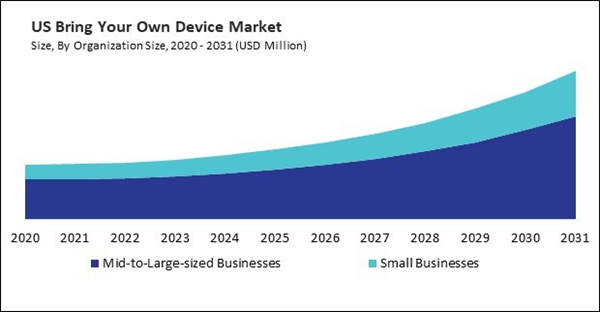The US market dominated the North America Bring Your Own Device Market by Country in 2023, and would continue to be a dominant market till 2031; thereby, achieving a market value of $159.61 billion by 2031. The Canada market is experiencing a CAGR of 15.6% during (2024 - 2031). Additionally, The Mexico market would exhibit a CAGR of 15.1% during (2024 - 2031).
Bring Your Own Device (BYOD) is a market that represents a radical shift in the way organizations function. This market has grown rapidly as organizations seek to leverage technological advancements in personal devices while reducing costs associated with providing company-issued hardware. BYOD allows employees to use smartphones, tablets, laptops, and other personal devices to access corporate networks and perform work-related tasks. Once considered unconventional, this practice has now become a mainstream business strategy, offering numerous benefits that continue to shape its evolution.
The rise of the BYOD sector can be traced back to the early 2000s when employees began carrying personal devices into the workplace as a result of the increasing prevalence of mobile technology. The prospective advantages of permitting employees to utilize mobile devices became increasingly apparent as they became more user-friendly and powerful. Businesses began to recognize that BYOD could reduce hardware costs, improve employee satisfaction, and enhance productivity by enabling workers to use devices they were already comfortable with. This realization began a shift in corporate policies, leading to the gradual acceptance and widespread adoption of BYOD practices.
In Mexico, the growing demand for BYOD is largely driven by the increased adoption of BYOD policies in the private and public sectors. The trend has continued post-pandemic, as businesses recognize the cost-saving potential and flexibility of allowing employees to use their devices. In sectors such as education and telecommunications, BYOD has become a critical component of remote work strategies, supported by government initiatives that promote digital transformation and workforce flexibility. As Mexico continues to invest in digital infrastructure, the demand for BYOD is expected to see sustained growth. Therefore, the region will present lucrative growth opportunities for the market throughout the forecast period.
Based on Organization Size, the market is segmented into Mid-to-Large-sized Businesses and Small Businesses. Based on Component, the market is segmented into Hardware (Smartphones, Tablets, and Laptops), Solutions (Mobile Device Management, Mobile Content Management, Mobile Application Management, Identity & Access Management, Endpoint Detection & Response, Mobile Expense Management, and Others), and Services (Professional Services {Deployment & Integration, Consulting, and Support & Maintenance} and Managed Services). Based on Industry, the market is segmented into IT, Energy & Utility, Retail, Healthcare, Automotive, and Others. Based on countries, the market is segmented into U.S., Mexico, Canada, and Rest of North America.
List of Key Companies Profiled
- Broadcom, Inc.
- IBM Corporation
- Microsoft Corporation
- Oracle Corporation
- Citrix Systems, Inc. (Cloud Software Group, Inc.)
- Cisco Systems, Inc.
- Ivanti, Inc. (Clearlake Capital Group, L.P.)
- HP, Inc.
- BlackBerry Limited
- SAP SE
- HCL Technologies Ltd.
Market Report Segmentation
By Organization Size- Mid-to-Large-sized Businesses
- Small Businesses
- Hardware
- Smartphones
- Tablets
- Laptops
- Solutions
- Mobile Device Management
- Mobile Content Management
- Mobile Application Management
- Identity & Access Management
- Endpoint Detection & Response
- Mobile Expense Management
- Others
- Services
- Professional Services
- Deployment & Integration
- Consulting
- Support & Maintenance
- Managed Services
- IT
- Energy & Utility
- Retail
- Healthcare
- Automotive
- Others
- US
- Canada
- Mexico
- Rest of North America
Table of Contents
Companies Mentioned
- Broadcom, Inc.
- IBM Corporation
- Microsoft Corporation
- Oracle Corporation
- Citrix Systems, Inc. (Cloud Software Group, Inc.)
- Cisco Systems, Inc.
- Ivanti, Inc. (Clearlake Capital Group, L.P.)
- HP, Inc.
- BlackBerry Limited
- SAP SE
- HCL Technologies Ltd.
Methodology

LOADING...









